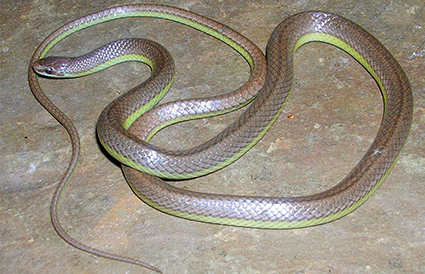Abstract
The genus Arrhyton is endemic to Cuba, with eight currently known species. A new species, Arrhyton albicollum sp. nov., is described from the karst areas of Gibara, Holguín Province. The new species is closely related to A. redimitum, another eastern species, according to morphology and molecular phylogeny. It differs from all other species of the genus by having a conspicuous, white nuchal band, a contrasting black pattern on the head, a gray-colored body with faint stripes, and a high number of ventral and subcaudal scales. Additional comments on other species include new locality records and information on morphology and relationships.
References
Amaro Valdés, S. & Morell Saval, E. (2017) First notes on reproduction of Cuban snakes in the endemic genus Arrhyton Günther 1858 (Squamata: Dipsadidae). IRCF Reptiles & Amphibians, 24 (1), 47–50. https://doi.org/10.17161/randa.v24i1.14143
Barbour, T. & Ramsden, C.T. (1919) The herpetology of Cuba. Memoirs of the Museum of Comparative Zoology, 47 (2), 71–213.
Cajigas, A. & Velazco, K. (2019) Arrhyton taeniatum (Gunther’s Island Racer). Geographic distribution. Herpetological Review, 50 (4), 748.
Cope, E.D. (1863) Synopsis of the species of Holcosus and Ameiva, with diagnoses of new West Indian and South American Colubridae. Proceedings of the Academy of Natural Sciences of Philadelphia, 14, 60–82.
Crother, B.I. (1999) Phylogenetic relationships among West Indian xenodontine snakes (Serpentes: Colubridae) with comments on the phylogeny of some mainland xenodontines. Contemporary Herpetology, 2, 7–30. https://doi.org/10.17161/ch.vi1.11935
Díaz, L.M., Cádiz, A., Villar, S. & Bermúdez, F. (2014) Notes on the ecology and morphology of the Cuban khaki trope, Tropidophis hendersoni Hedges and Garrido (Squamata: Tropidophiidae), with a new locality record. IRCF Reptiles & Amphibians, 21, 116–119. https://doi.org/10.17161/randa.v21i4.14009
Dowling, H.G. (1951) A proposed standard system of counting ventrals in snakes. British Journal of Herpetology, 1, 97–99.
González, H., Rodríguez-Schettino, L., Rodríguez, A., Mancina, C.A. & Ramos García, I. (2012) Libro Rojo de los vertebrados de Cuba. Instituto de Ecología y Sistemática, Editorial Academia, 304 pp.
Grant, C., Smith, H.M. & Alayo Dalmau, P. (1959) The status of snakes of the genus Arrhyton in Cuba. Herpetologica, 15, 129–133.
Grazziotin, F.G., Zaher, H., Murphy, R.W., Scrocchie, G., Benavides, M.A., Zhang, Y.-P. & Bonattoh, S.L. (2012) Molecular phylogeny of the New World Dipsadidae (Serpentes: Colubroidea): a reappraisal. Cladistics, 28, 437–459. https://doi.org/10.1111/j.1096-0031.2012.00393.x
Gundlach, J.C. (1880) Contribución á la erpetología cubana. Imprenta de G. Montiel & Ca., Habana, 99 pp. https://doi.org/10.5962/bhl.title.11859
Günther, A. (1858) Catalogue of Colubrine snakes of the British Museum. Printed by order of the Trustees, London, XVI + 281 pp.
Hedges, S.B., Powell, R., Henderson, R.W., Hanson, S. & Murphy, J.C. (2019) Definition of the Caribbean Islands biogeographic region, with checklist and recommendations for standardized common names of amphibians and reptiles. Caribbean Herpetology, 67, 1–53. https://doi.org/10.31611/ch.67
Hedges, S.B. & Garrido, O.H. (1992) Cuban snakes of the genus Arrhyton: two new species and a reconsideration of A. redimitum Cope. Herpetologica, 48 (2), 168–177.
Hedges, S.B., Couloux, A. & Vidal, N. (2009) Molecular phylogeny, classification, and biogeography of West Indian racer snakes of the tribe Alsophiini (Squamata, Dipsadidae, Xenodontinae). Zootoxa, 2067 (1), 1–28. https://doi.org/10.11646/zootaxa.2067.1.1
Henderson, R.W. & Powell, R. (2009) Natural History of West Indian Reptiles and Amphibians. University Press of Florida, Gainesville, Florida, xxiv + 496 pp.
IUCN (2021) The IUCN Red List of Threatened Species. Version 2021-1. Available from: https://www.iucnredlist.org (accessed 22 July 2021)
Kumar, S., Stecher, G., Li, M., Knyaz, C. & Tamura, K. (2018) MEGA X: Molecular Evolutionary Genetics Analysis across computing platforms. Molecular Biology and Evolution, 35, 1547–1549. https://doi.org/10.1093/molbev/msy096
Maglio, V.J. (1974) West Indian xenodontine colubrid snakes: their probable origin, phylogeny, and zoogeography. Bulletin of the Museum of Comparative Zoology, 141 (1), 1–54.
Peters, J.A. (1964) Dictionary of herpetology: a brief and meaningful definition of words and terms used in herpetology. Hafner, New York, 430 pp.
Rodríguez Schettino, L., Mancina, C.A. & Rivalta González, V. (2013) Reptiles of Cuba: Checklist and geographic distributions. Smithsonian Herpetological Information Service, 144, 1–92. https://doi.org/10.5479/si.23317515.144.1
Schwartz, A. (1965) A review of the colubrid snake genus Arrhyton with a description of a new subspecies from southern Oriente province, Cuba. Proceedings of the Biological Society of Washington, 78, 99–114.
Schwartz, A. & Garrido, O.H. (1981) A review of the Cuban members of the genus Arrhyton (Reptilia, Serpentes, Colubridae). Annals of Carnegie Museum, 50 (7), 207–230.
Schwartz, A. & Henderson, R.W. (1991) Amphibians and Reptiles of the West Indies. Descriptions, distributions, and natural history. University of Florida Press, Gainesville, xvi + 720 pp.
Uetz, P., Freed, P., Aguilar, R. & Hošek, J. (2021) The Reptile Database. Available from: http://www.reptile-database.org (accessed 18 June 2021)
Zaher, H., Murphy, R.W., Arredondo, J.C., Graboski, R., Machado-Filho, P.R., Mahlow, K., Montingelli, G.G., Bottallo Quadros, A., Orlov, N.L., Wilkinson, M., Zhang, Y.-P. & Grazziotin, F.G. (2019) Large-scale molecular phylogeny, morphology, divergence-time estimation, and the fossil record of advanced caenophidian snakes (Squamata: Serpentes). PLoS ONE, 14 (5), e0216148. https://doi.org/10.1371/journal.pone.0216148


